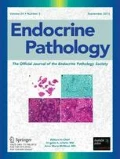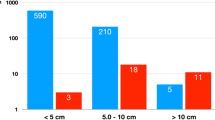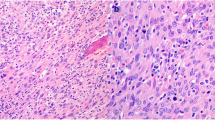Abstract
Discerning malignancy in resected adrenocortical neoplasms can pose diagnostic difficulty. Macroscopic examination is the first important step toward diagnosis and should include accurate measurement of weight and dimension of the specimens and description of the cut surface of the tumors. It is also important to sample the specimens for histological diagnosis near foci of hemorrhage and/or necrosis. Histological scoring systems evaluating multiple parameters, especially the criteria of Weiss, have been shown to be reliable in differential diagnosis between adrenocortical adenoma and carcinoma. A tumor is defined as adrenocortical carcinoma when three or more of the following criteria are met; (1) high nuclear grade, (2) mitotic rate six or more per 50 high power fields, (3) atypical mitosis, (4) clear cells less than 25%, (5) a diffuse architecture pattern in more than one-third of the tumor, (6) confluent necrosis, (7) venous invasion, (8) sinusoidal invasion, and (9) capsular invasion. The criteria are relatively straightforward and considered the most effective standard for diagnosis of adrenocortical malignancy. However, great care should be taken in applying the criteria to histological evaluation of two relatively rare and peculiar adrenocortical tumors, adrenocortical oncocytoma and pediatric adrenocortical neoplasms. At this juncture, ancillary biological or molecular markers are of little practical value in terms of differential diagnosis between adrenocortical adenoma and carcinoma but tumors with MIB1 or Ki-67 labeling index more than 2.5 may be considered malignant. Prognostic markers of adrenocortical carcinoma have not been established other than complete respectability of the tumor. There are also no surrogate markers for predicting response to therapy with Mitotane, an adrenolytic agent. It sometimes is important for surgical pathologists to differentiate adrenocortical carcinoma from metastatic malignancies of other sites. An immunohistochemical evaluation of adrenal 4 binding protein (Ad4BP) or SF-1, a transcription factor of all steroidogenesis, can aid in this differential diagnosis because nuclear immunoreactivity for this transcription factor is relatively specific to steroid producing cells.
Similar content being viewed by others
References
Sasano N. Functional pathology of adrenocortical endocrine disorders. Trans Soc Pathol Jpn 64:31–54, 1975.
Sasano N, Sasano H. The adrenal cortex. In: Kovacs K, Asa SL, eds. Functional endocrine pathology. Oxford: Blackwell, 1998, 546–584.
Gandour, MJ, Grizzle WE. A small adrenocortical carcinoma with aggressive behavior. An evaluation of criteria for malignancy. Arch Pathol Lab Med 110:1076–1079, 1986.
Hough AJ, Hollifield, JW, Page DL, Hartmann WH. Prognostic factors in adrenal cortex tumors: a mathematical analysis of clinical and morphological data. Am J Clin Pathol 72:390–399, 1979.
Weiss LM. Comparable histologic study of 43 metastasizing and nonmetastasizing adrenocortical tumors. Am J Surg Pathol 8:163–169, 1984.
Weiss LM, Medeiros LJ, Vickery AL. Pathologic features of prognostic significance in adrenocortical carcinoma. Am J Surg Pathol 13:202–206, 1989.
Sasano H, Suzuki T, Sano T, et al. Adrenocortical oncocytoma–a true nonfunctioning adrenocortical tumor. Am J Surg Pathol 15:949–956, 1991.
Hoang MP, Ayala AG, Albores-Saavedra J. Oncocytic adrenocortical carcinoma: a morphologic, immunohistochemical and ultrastructural study of four cases. Mod Pathol 15:973–978, 2002.
Wieneke JA, Thompson LDR, Heffess CS Adrenal cortical neoplasms in the pediatric population. A clinicopathological and immunophenotypic analysis of 83 patients, Am J Surg Pathol 77:867–881, 2003.
Lack EE, Mulivihil JJ, Travis WD, et al. Adrenocortical neoplasms in the pediatric and adolescent age group. Clinicopathological study of 30 cases with emphasis on epidemiological and prognostic factors. Pathol Annu 27:1–53, 1992.
Mickalkiexicz EL, Sandrini R, Figueriredo B, et al. Clinical and outcome characteristics of children with adrenocortical tumors: a report from the international pediatric adrenocortical registry. J Clin Oncol 22:838–845, 2004.
Stojadinovic, A, Ghossein RA, Hoos A, et al. Adrenocortical carcinoma: clinical, morphologic, and molecular characterization. J Clin Oncol 15:941–950, 2002.
Stratakis CA. Genetics of adrenocortical tumors: gatekeepers, landscapers and conductors in symphony. Trends Endocrinol Metab 14:404–410, 2003.
Sidhu S, Gicquel C, Bambach CP, et al. Clinical and molecular aspects of adrenocortical tumorigenesis. ANZ J Surg 73:727–738, 2003.
Iino K, Sasano H, Yabuki N, et al. DNA topoisomerase II alpha and Ki-67 in human adrenocortical neoplasms: a possible marker of differentiation between adenomas and carcinomas. Mod Pathol 10:901–907, 1997.
Nakazumi H, Sasano H, Iino K, Ohashi Y, Orikasa S. Expression of cell cycle inhibitor p27 and Ki-67 in human adrenocortical neoplasms. Mod Pathol 11:1165–1170, 1998.
Martins ACP, Cologna AJ, Tucci S, et al. Clinical features and immunoexpression of p53, MIB-1 and proliferating cell nuclear antigen in adrenal neoplasms. J Urol 173:2138–2142, 2005.
Bernini GP, Moretti A, Viacava, P, et al. Apoptosis control and proliferation marker in human normal and neoplastic adrenocortical tissues. Br J Cancer 86:1561–1565, 2002.
Wachenfeld C, Beuschlein, F, Zwermann O, et al. Discerning malignancy in adrenocortical tumors: are molecular markers useful? Eur J Endocrinol 145:335–341, 2001.
Terzolo M, Boccuzzi A, Bovio S, et al. Immunohistochemical assessment of Ki-67 in the differential diagnosis of adrenocortical tumors. Urology 57:176–182, 2001.
Krishnamurthy S, Ordonez NG, Shelton TO, et al. Fine-needle aspiration cytology of a case of oncotytic adrenocortical carcinoma. Diagn Cytopathol 22:299–303, 2000.
Sasano H, Shizawa S, Nagura H. Adrenocortical cytopathology. Am J Clin Pathol 104:161–166, 1995.
Ng L, Libertino JM. Adrenocortical carcinoma: diagnosis, evaluation and treatment. J Urol 169:5–11, 2003.
Harrison LF, Gaudin PB, Brennan MF. Pathologic features of prognostic significance for adrenocortical carcinoma after curative resection. Arch Surg 134:181–185, 1999.
Hahner S, Fassnacht M. Mitotane for adreno-cortical carcinoma treatment. Curr Opin Investig Drugs 6:386–394, 2005.
Berruti A, Terzolo M, Pia A, et al. Mitotane associated with etoposide, doxorubicin, and cisplatin in treatment of advanced adrenocortical carcinoma. Italian group study of adrenal cancer. Cancer 83:2194–2200, 1998.
Neville AM, O'Hare MJ. The human adrenal cortex. Berlin, Germany: Springer Verlag, 1982.
Sasano H, Okamoto M, Sasano N. Immuno-histochemical study of human adrenal cortex with mineralo- and glucocorticoid excess. Virchows Arch [A] 413:313–318, 1988.
Sasano H. Localization of steroidogenic enzymes in adrenal cortex and its disorders. Endocrine J 41:471–482, 1994.
Sasano H. New approaches in human adrenocortical pathology: assessment of adrenocortical function in surgical specimen of human adrenal glands. Endocr Pathol 3:4–13, 1992.
Tartour E, Caillou B, Tenenbaum F, et al. Immunohistochemical study of adrenocortical carcinoma: predictive value of the D11 monoclonal antibody. Cancer 72:3296–3303, 1993.
Sasano H, Shizawa S, Suzuki T, et al. Transcription factor adrenal 4 binding protein as a marker of adrenocortical malignancy. Hum Pathol 26:1154–1156, 1995.
Takayama K, Sasano H, Fukaya T, et al. Immunohistochemical localization of Ad4-binding protein with correlation to steroidogenic enzyme expression in cycling human ovaries and sex cord stromal tumors. J Clin Endocrinol Metab. 80:2815–2821, 1995.
Author information
Authors and Affiliations
Corresponding author
Rights and permissions
About this article
Cite this article
Sasano, H., Suzuki, T. & Moriya, T. Recent advances in histopathology and immunohistochemistry of adrenocortical carcinoma. Endocr Pathol 17, 345–354 (2006). https://doi.org/10.1007/s12022-006-0006-0
Issue Date:
DOI: https://doi.org/10.1007/s12022-006-0006-0




